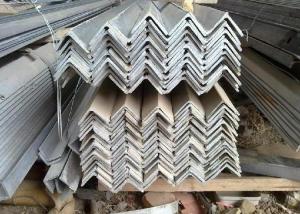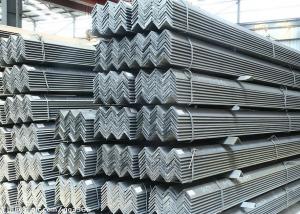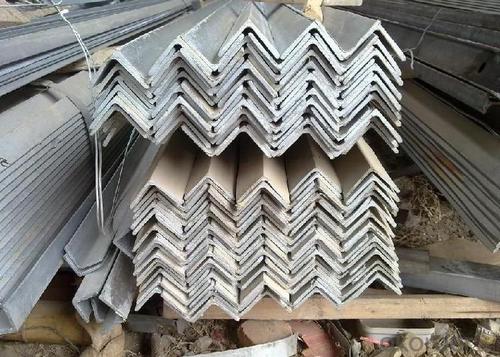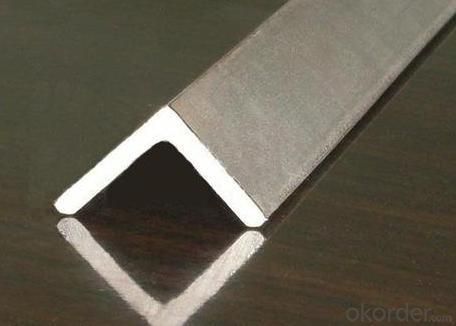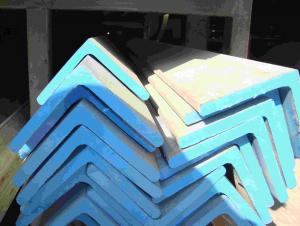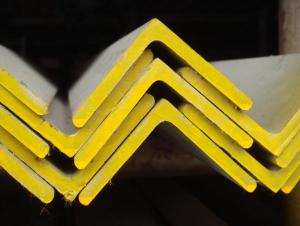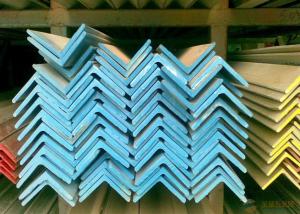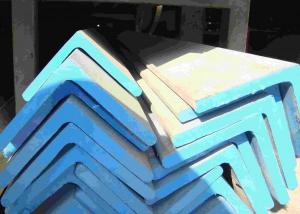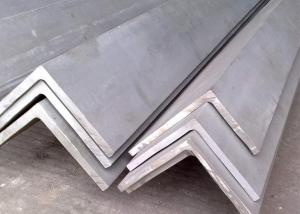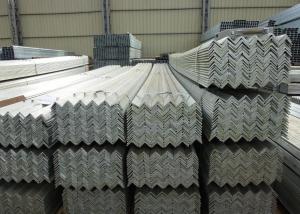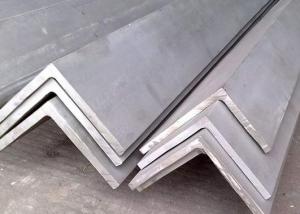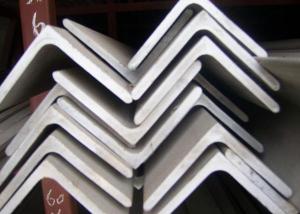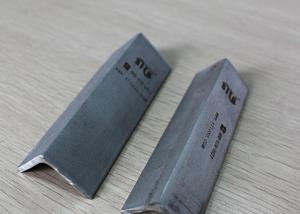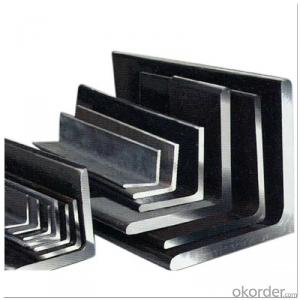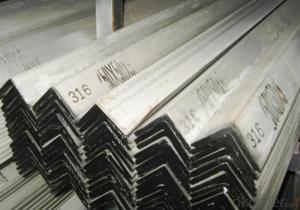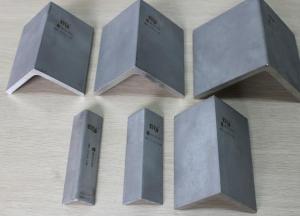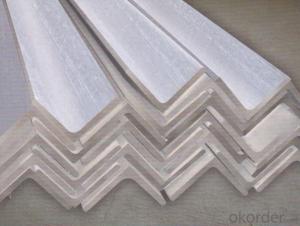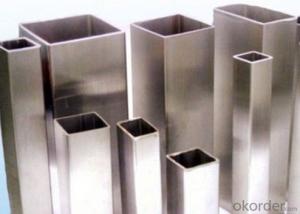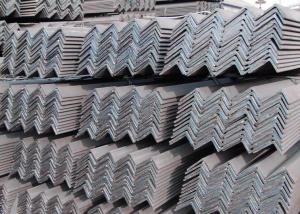304L Stainless Steel Angles
- Loading Port:
- China Main Port
- Payment Terms:
- TT or LC
- Min Order Qty:
- 5 Tons m.t.
- Supply Capability:
- 1000 Tons Per Month m.t./month
OKorder Service Pledge
OKorder Financial Service
You Might Also Like
Stainless Steel Angles
1.Grade: SS200,300,400 series
2.Size: 25×25×3 mm-100×100×10mm
3.Process: HRAP
4. Length: 2-6m
5. Shape: Equal
6. Delivery: within 20 days
7. MOQ: 1 ton
8. Certificate: ISO 9001:2008, SGS
9. Package:Standard Export Packing, or put into wooden boxes according to your
requirement
10. Application: Construction, Marine, Industry and so on
|
Name |
Stainless Steel Angles | ||||||
|
Standard |
ASTM A554, A312, A249, A269 and A270 | ||||||
|
Material Grade |
304,316,201,202, 316L,430 | ||||||
|
Length |
6m or as customers' request | ||||||
|
Tolerance |
a) thickness: +/-0. 15mm | ||||||
|
| |||||||
|
b) Length:+/-4. 5mm - 0mm | |||||||
|
Surface |
180G, 320G, 400G Satin / Hairline(Matt Finish, Brush, Dull Finish) 400G, 500G, 600G or 800G Mirror finish | ||||||
|
Application |
Decoration construction, upholstery, industry instruments | ||||||
|
Test |
Squash test, Extended test, Water pressure test, Crystal rot test, Heat treatment, NDT | ||||||
|
Chemical Composition of Material |
Composition
Material |
201 |
202 |
304 |
316L |
430 | |
|
C |
≤0.15 |
≤0.15 |
≤0.08 |
≤0.08 |
≤0.12 | ||
|
Si |
≤1.00 |
≤1.00 |
≤1.00 |
≤1.00 |
≤1.00 | ||
|
Mn |
5.5-7.5 |
7.5-10 |
≤2.00 |
≤2.00 |
≤1.00 | ||
|
P |
≤0.06 |
≤0.06 |
≤0.045 |
≤0.045 |
≤0.040 | ||
|
S |
≤0.03 |
≤0.03 |
≤0.030 |
≤0.030 |
≤0.030 | ||
|
Cr |
16-18 |
17-19 |
18-20 |
16-18 |
16-18 | ||
|
Ni |
3.5-5.5 |
4-6 |
8-10.5 |
10-14 |
| ||
|
Mo |
|
|
|
2.0-3.0 |
| ||
|
Mechanical Property |
Material Item |
201 |
202 |
304 |
316L | ||
|
Tensile Strength |
≥535 |
≥520 |
≥520 |
≥520 | |||
|
Yield Strength |
≥245 |
≥205 |
≥205 |
≥205 | |||
|
Extension |
≥30% |
≥30% |
≥35% |
≥35% | |||
|
Hardness (HV) |
<253 |
<253 |
<200 |
<200 | |||
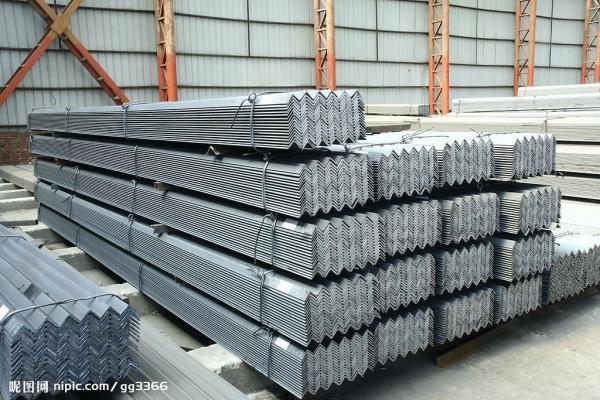
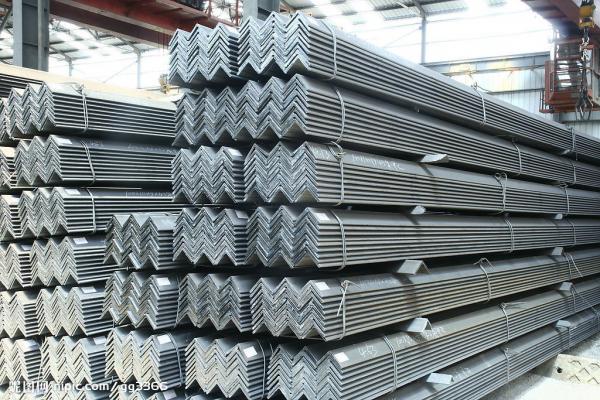
- Q: What is the resistance to oxidation of stainless steel angles?
- Stainless steel angles have a high resistance to oxidation due to the presence of chromium in their composition. Chromium forms a protective layer of chromium oxide on the surface of the steel, which acts as a barrier against further oxidation. This chromium oxide layer is self-repairing, meaning that if it is damaged or scratched, it will reform and continue to protect the steel from oxidation. This resistance to oxidation makes stainless steel angles suitable for a wide range of applications where exposure to moisture or corrosive environments is a concern.
- Q: What is a stainless steel angle?
- A stainless steel angle is a type of metal profile that features two sides that are perpendicular to each other, forming a right angle. It is made from stainless steel, which is an alloy of iron, chromium, and other elements that provide corrosion resistance and durability. The angle shape allows for structural support and reinforcement in various applications, such as construction, architecture, and manufacturing. Stainless steel angles can be found in a range of sizes and thicknesses, making them versatile for different projects. They are commonly used for framing, bracing, and supporting structures, as well as for decorative purposes. Due to the stainless steel material, these angles are resistant to rust, staining, and other forms of corrosion, making them ideal for both indoor and outdoor use.
- Q: Are stainless steel angles resistant to extreme temperatures?
- Yes, stainless steel angles are highly resistant to extreme temperatures.
- Q: Are stainless steel angles suitable for decorative purposes?
- Yes, stainless steel angles are suitable for decorative purposes. Their sleek and modern appearance, combined with their durability and resistance to corrosion, make them an excellent choice for adding a touch of elegance to any space. Additionally, stainless steel angles can be easily shaped and formed to create various decorative designs, making them versatile for a wide range of applications.
- Q: How do stainless steel angles contribute to the overall safety of a product?
- Stainless steel angles have a crucial role in enhancing a product's safety in multiple ways. To begin with, stainless steel is renowned for its exceptional durability and strength, which makes it highly resistant to corrosion, impact, and wear. When used to construct angles, stainless steel imparts structural integrity and stability to the product, ensuring its sturdiness and reliability. Consequently, this reduces the risk of structural failure or collapse, thus enhancing safety. Additionally, stainless steel angles are commonly employed as protective barriers or guards in various applications. For instance, in machinery or industrial equipment, stainless steel angles can shield moving parts or hazardous components, preventing accidental contact or injuries. Moreover, the corrosion resistance of stainless steel enables these angles to withstand harsh environments and exposure to chemicals, further bolstering the product's safety. Another vital aspect of stainless steel angles is their fire resistance. Due to its high melting point and inability to contribute to fire spread, stainless steel is a suitable material for applications where fire safety is paramount. By incorporating stainless steel angles, products can adhere to fire safety regulations and help prevent the escalation of potential fire hazards. Furthermore, stainless steel angles find frequent usage in construction and architectural projects to provide structural support and reinforcement. By adding strength and stability, these angles contribute to the overall integrity of buildings, bridges, or other structures, diminishing the risk of collapse or structural failure. In summary, stainless steel angles contribute to a product's safety by providing durability, strength, protection, fire resistance, and structural support. Their reliability and ability to withstand harsh conditions ensure the safe utilization of the product, safeguarding both users and the surrounding environment.
- Q: How do you calculate the moment of inertia for a rounded corner stainless steel angle?
- To calculate the moment of inertia for a rounded corner stainless steel angle, you will need to consider the shape of the angle and its dimensions. The moment of inertia measures an object's resistance to changes in its rotational motion, and it is determined by the distribution of mass around the axis of rotation. First, you need to determine the shape of the rounded corner stainless steel angle. Is it a simple L-shape or does it have additional features? If it is a simple L-shape, you can assume it consists of two perpendicular rectangular sections connected at a rounded corner. Next, measure the dimensions of the angle. You will need the lengths of the two legs of the angle and the radius of the rounded corner. Let's call the length of the horizontal leg "a", the length of the vertical leg "b", and the radius of the rounded corner "r". To calculate the moment of inertia for the rounded corner stainless steel angle, you can use the parallel axis theorem. This theorem states that the moment of inertia about an axis parallel to and a distance "d" away from the axis passing through the center of mass is equal to the moment of inertia about the center of mass plus the product of the mass and the square of the distance "d". For the L-shaped section of the angle, you can calculate the moment of inertia using the formula for a rectangular section: I_rectangular = (1/12) * (a * b^3) Then, you need to consider the rounded corner. The rounded corner can be approximated as a quarter of a circle with radius "r". The moment of inertia for a quarter of a circle about an axis passing through its center is given by: I_quarter circle = (1/4) * (pi * r^4) To calculate the moment of inertia for the rounded corner, you will need to apply the parallel axis theorem. The distance "d" in this case is the distance from the center of the rounded corner to the center of mass of the L-shaped section. This distance can be calculated as the sum of the horizontal leg length "a" and half of the vertical leg length "b". Finally, you can calculate the moment of inertia for the rounded corner stainless steel angle by summing the moments of inertia for the L-shaped section and the rounded corner: I_total = I_rectangular + I_quarter circle Keep in mind that this calculation assumes a simplified model of the rounded corner stainless steel angle and may not be perfectly accurate. If a more precise calculation is required, you may need to consider the actual geometry and possibly use numerical methods or computer simulations.
- Q: What are the different types of stainless steel angles available?
- There are several different types of stainless steel angles available, including equal angles, unequal angles, and L-shaped angles. Equal angles have equal sides and are commonly used for structural applications. Unequal angles have different side lengths and are often used in architectural and decorative projects. L-shaped angles, also known as corner brackets, are used to join two perpendicular pieces of stainless steel.
- Q: How do stainless steel angles perform in extreme temperature conditions?
- Stainless steel angles are renowned for their outstanding performance even in the most extreme temperature conditions. Thanks to their unique composition, which includes a high concentration of chromium, stainless steel angles demonstrate remarkable resistance to both oxidation and corrosion at both high and low temperatures. This exceptional quality renders them highly suitable for a diverse array of applications that involve exposure to extreme temperatures. When subjected to high temperatures, stainless steel angles maintain their strength and structural integrity, making them the perfect choice for industries such as aerospace, automotive, and power generation. They can endure heat levels of up to approximately 1400°C (2550°F) without any significant deformation or loss of mechanical properties. Conversely, stainless steel angles also exhibit exceptional performance in environments with low temperatures. They retain their toughness and ductility even under extremely cold conditions, making them a valuable asset in cryogenic applications. This property proves particularly advantageous in industries like oil and gas, chemical processing, and food processing, where encounters with low temperatures are frequent. Furthermore, stainless steel angles possess a low thermal expansion coefficient, ensuring minimal expansion and contraction compared to other materials when confronted with temperature fluctuations. This unique characteristic allows them to maintain dimensional stability and greatly reduces the risk of distortion or warping, especially in applications where temperature changes are inherent. All in all, stainless steel angles offer unparalleled reliability and perform exceptionally well in extreme temperature conditions. Their ability to resist oxidation, corrosion, and thermal expansion, coupled with their retained strength and toughness, make them an outstanding choice for a wide range of applications across various industries.
- Q: Can stainless steel angles be used for outdoor furniture?
- Yes, stainless steel angles can be used for outdoor furniture. Stainless steel is highly resistant to corrosion and rust, making it a suitable choice for outdoor applications. Its durability and strength also make it ideal for withstanding various weather conditions and providing long-lasting support for outdoor furniture.
- Q: What are the advantages of using stainless steel angle?
- There are several advantages of using stainless steel angle in various applications. Firstly, stainless steel is highly resistant to corrosion, making it ideal for use in environments where exposure to moisture, chemicals, or harsh weather conditions is a concern. This corrosion resistance helps to extend the lifespan of stainless steel angle, reducing the need for frequent replacements and saving on maintenance costs. Secondly, stainless steel angle offers excellent strength and durability. It has a high tensile strength, allowing it to withstand heavy loads and pressure. This makes it suitable for structural applications where strength and stability are paramount, such as in construction, industrial machinery, and transportation. Moreover, stainless steel angle has an attractive appearance, providing a polished and modern look to any project or application. Its sleek and shiny surface is easy to clean and maintain, making it a popular choice in industries that require hygienic conditions, such as food processing, pharmaceutical, and medical applications. Additionally, stainless steel angle is highly versatile and can be easily fabricated or modified to suit specific requirements. It can be welded, cut, bent, and formed into various shapes and sizes, allowing for a wide range of design possibilities. This versatility makes stainless steel angle suitable for a wide range of applications, including architectural projects, furniture manufacturing, and decorative purposes. Lastly, stainless steel is a sustainable and environmentally friendly material. It is fully recyclable, meaning it can be repurposed or reused without losing its properties. This reduces waste and contributes to a more sustainable and circular economy. Overall, the advantages of using stainless steel angle include corrosion resistance, high strength and durability, attractive appearance, versatility in fabrication, and sustainability. These qualities make stainless steel angle a reliable and cost-effective choice for a wide range of applications across various industries.
1. Manufacturer Overview
| Location | Jiangsu, China |
| Year Established | 2010 |
| Annual Output Value | above US$3 million |
| Main Markets | East Asia, Middle East. |
| Company Certifications |
2. Manufacturer Certificates
| a) Certification Name | |
| Range | |
| Reference | |
| Validity Period |
3. Manufacturer Capability
| a) Trade Capacity | |
| Nearest Port | Shanghai |
| Export Percentage | 50% |
| No.of Employees in Trade Department | above 10 people |
| Language Spoken: | English, Chinese |
| b) Factory Information | |
| Factory Size: | about 50000 square meter |
| No. of Production Lines | above 3 |
| Contract Manufacturing | OEM Service Offered |
| Product Price Range | Average |
Send your message to us
304L Stainless Steel Angles
- Loading Port:
- China Main Port
- Payment Terms:
- TT or LC
- Min Order Qty:
- 5 Tons m.t.
- Supply Capability:
- 1000 Tons Per Month m.t./month
OKorder Service Pledge
OKorder Financial Service
Similar products
Hot products
Hot Searches
Related keywords
